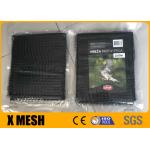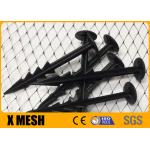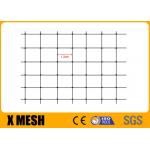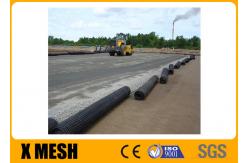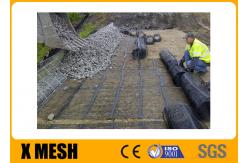Extends pavement life Length 100m Width 4m ASTM D6637 Standard Uniaxial Geogrid Uniaxial Geogrid Introduction: Uniaxial Geogrid Certain Uniaxial (UX) geogrids are oriented along the longitudinal, "machine direction" of an extruded sheet of polymer, thus yielding a grid structure consisting of long narrow ribs. Other products utilize polyester yarns to render extremely high allowable strengths at deficient strains. Given their unique properties, Uniaxial geogrids are ideal for both wall and slope applications such as retaining walls, landfill liner systems, embankments over soft soils, and very steep earthen slopes.
The properties of Biaxial Geogrids, made of Polypropylene (PP) with their square apertures, high tensile strength and optimised geometry of nodes and ribs make them equal to any other similar material. The reinforcing action of PP Biaxial Geogrids lies mainly in confining soil and increasing its shearing resistance by a process of interlocking between the square ribs and the soil. The load dispersal effect from the interlocking mechanism is highly effective and can reduce sub-base thickness and construction cost. PP Biaxial Geogrids can be used with any kind of mechanical fill material. Two aperture size ranges are available for optimum matching with project fill.
What are geogrids? By now, you have probably read or heard about the multiple benefits of using geogrids in various types of civil engineering construction applications. The two most significant are the improvement of your construction project's speed and the reduction of your overall cost. But you might still be asking yourself, what exactly are geogrids and how do they create an impact on my bottom line and project's success? What is a geogrid? A geogrid is defined as a geosynthetic material consisting of connected parallel sets of tensile ribs with apertures of sufficient size to allow strike-through of the surrounding soil, stone, or other geotechnical material (Qijie Company). Geogrids provide reinforcement, stabilization, and even filtration when used with properly sized aggregate fills. Made from polymers such as polypropylene, polyethylene, or polyester, they are used widely in civil engineering applications. Geogrids are deployed for three primary applications: 1. Building firm working surfaces over soft ground conditions 2. Enhance a pavement's service life 3. Reduce the structural cross-section of both paved and unpaved roadways for given service life. Geogrids have also been proven to significantly improve a pavement's susceptibility to environmental cracking common when building over highly expansive subgrade soils. Geogrids work by interlocking with the granular or soil material placed over them. The open apertures of the geogrid allow for the confinement of material within, increasing the shear strength of overlying granular fill. The different types of geogrids? There are four types of geogrids Uniaxial, Biaxial, Triaxial (Triax®) and Geogrid-Geotextile Composites. Each designed and manufactured for specific construction applications with various geometric and structural index properties. Biaxial Geogrid Biaxial (BX) geogrids are stretched in two directions, the longitudinal and transverse, equally distributing stress along both directions. While woven geogrids are still commercially available, extruded punched-and-drawn geogrids made of polypropylene are the most deployed among biaxial geogrids. Providing the geogrid with the ability to distribute loads over a wider area than usual while increasing its capacity in base stabilization applications. Biaxial geogrids are best for applications such as foundations for roadbeds, railroad truck beds, permanent unpaved roads, airport runways, construction haul roads, working platforms on weak subgrades, and parking lots. Triaxial Geogrid TriAx® (TX) geogrids, a next-generation enhancement to biaxial geogrids, have additional diagonal ribs that increase the product's in-plane stiffness. The triangular pattern is formed into a hexagon to improve how the product absorbs traffic loading forces. TriAx® creates a more efficient effect that delivers optimal in-service stress transfer from the aggregate to the geogrid. Triaxial geogrids have undergone extensive full-scale and field testing and have been calibrated within the more common pavement design methodologies, both for paved and unpaved roads. Uniaxial Geogrid Specifications: Index Properties | Test Method | Unit | GG1515 | GG2020 | GG3030 | GG4040 | MD TD | MD TD | MD TD | MD TD | Polymer | -- | -- | PP | PP | PP | PP | Minimum Carbon Black | ASTM D 4218 | % | 2 | 2 | 2 | 2 | Tensile Strength@ 2% Strain | ASTM D 6637 | Kn/m | 5 5 | 7 7 | 10.5 10.5 | 14 14 | Tensile Strength@ 5% Strain | ASTM D 6637 | Kn/m | 7 7 | 14 14 | 21 21 | 28 28 | Ultimate Tensile Strength | ASTM D 6637 | Kn/m | 15 15 | 20 20 | 30 30 | 40 40 | Strain @ Ultimate Strength | ASTM D 6637 | % | 13 10 | 13 10 | 13 10 | 13 10 | Structural Integrity plastic geogrid | Junction Efficiency | GRI GG2 | % | 93 | 93 | 93 | 93 | Flexural Rigidity | ASTM D 1388 | Mg-cm | 700000 | 1000000 | 3500000 | 10000000 | Aperture Stability | COE Method | mm-N/deg | 646 | 707 | 1432 | 2104 | Dimensions bx geogrid | Roll Width | -- | M | 3.95 | 3.95 | 3.95 | 3.95 | Roll Length | -- | M | 50 | 50 | 50 | 50 | Roll Weight | -- | Kg | 39 | 50 | 72 | 105 | MD denotes Machine direction. TD denotes transverse direction. plastic geogrid | Item | TGSG15-15 | TGSG20-20 | TGSG25-25 | TGSG30-30 | TGSG35-35 | TGSG40-40 | TGSG45-45 | Longgitudinal Tensile strength ≥ (KN/m) | 15 | 20 | 25 | 30 | 35 | 40 | 45 | Transverse Tensile strength ≥ (KN/m) | 15 | 20 | 25 | 30 | 35 | 40 | 45 | Longitudunal Elongation ≤ (%) | 15 | Transverse Elongation ≤ (%) | 13 | Longitudinal Tensile strength
at 2% strain ≥ (KN/m) | 5 | 7 | 9 | 10.5 | 30 | 30 | 30 | Transverse Tensile strength
at 2% strain ≥ (KN/m) | 5 | 7 | 9 | 10.5 | 30 | 30 | 30 | Longitudinal Tensile strength
at 5% strain ≥ (KN/m) | 7 | 14 | 17 | 21 | 24 | 28 | 32 | Transverse Tensile strength
at 5% strain ≥ (KN/m) | 7 | 14 | 17 | 21 | 24 | 28 | 32 | Width ≤ (m) | 6 | Item | GSJ30- 30 | GSJ35- 35 | GSJ50- 50 | GSJ80- 80 | GSJ100 100 | GSJ125- 125 | GSJ150-150 | Limit tensile strength (MD or TD) KN/M | ≥30 | ≥35 | ≥50 | ≥80 | ≥100 | ≥125 | ≥150 | The elongation at nominal % | ≤13 | ≤13 | ≤13 | ≤13 | ≤13 | ≤14 | ≤14 | The elongation at 2%nominal Tensile strength (MD or TD) KN/M | ≥10 | ≥12 | ≥17 | ≥28 | ≥35 | ≥43 | ≥52 | The tensile force at 5% elongation (MD or TD) KN/M | ≥20 | ≥24 | ≥34 | ≥56 | ≥70 | ≥86 | ≥104 | Item | value | Type | Geogrids | Brand Name | QJ | Model Number | PP | Raw Material | Polypropylene | Tensile strength | 15-50kN/m | Width | 2/3.95/5.9m | Length | 50-100m | Certificate | CE /ISO9001 | Carbon black | 2% | Elongation | 13% | Mesh size | 30-65mm | Application | Road construction,soil reinforcement,mine Laneway... | Uniaxial Geogrid Feature: •High Tear Strength
•Flexible and durable
•Excellent Creep Resistance
•UV resistance
•Cost effective
•High chemical and biological resistance
•High Tensile Strength and Low Elgongation
•Optimun stability of the junction strength of the grid
•Increased pull-out resistance and compound strength
•High resistance to installation damage and ease of installation Uniaxial Geogrid Application: 1. Reinforcement and Stabilisation of earth fencing walls, railways, highways and water conservation projects; 2. Reinforcement of road foundations;
3. Retaining walls;
4. Road slope repair and reinforcement;
5. Be used in noise barriers construction.
Site subgrades and/or sub-bases Railway ballasts Parking lots Temporary and access roads Access roads Haul roads Foundation and transmission line tower bases Uniaxial Geogrid Packing & Delivery: Item | Roll Size | Load quantity of 1 X 40' hq container | 20 Kn X 20 Kn | width 3.95 m * length 50 m | 220 rolls, 43450 Sq. m | 30 Kn X 30 Kn | width 3.95 m * length 50 m | 144 rolls, 28440 Sq. m | 40 Kn X 40 Kn | width 3.95 m * length 50 m | 90 rolls, 17775 Sq. m | 50 Kn X 50 Kn | width 3.95 m * length 50 m | 60 rolls, 11850 Sq. m |
Delivery Time: 3-15 days
Sample Time: 1-3 days
Payment Methord: T/T, L/C, Western Union or as per negotiate

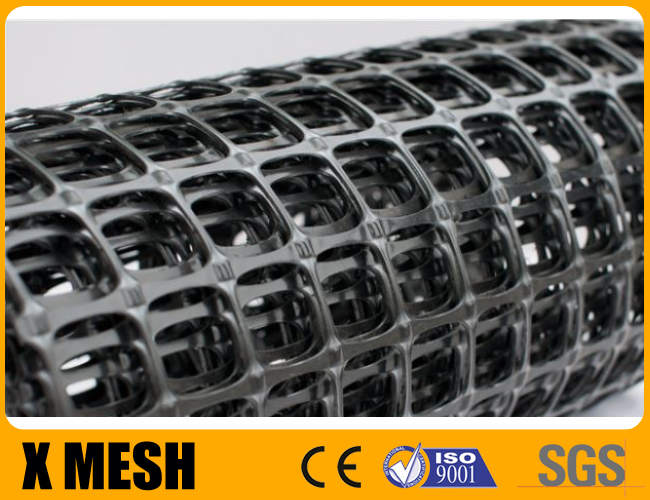



|








